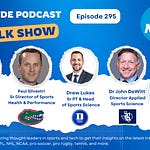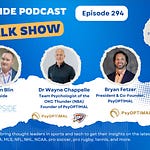Today we have the honor of interviewing Dr. John DeWitt, the director of applied sports science in the athletic department and a faculty member at Rice University (NCAA).
Dr. John DeWitt has been working a Rice University since July 2023. In this role, he aims to develop a premier sports science program that integrates various sports within the department and collaborates with external research partners. Prior to joining Rice, Dr. DeWitt served as the Senior Biomechanist and Exercise Device Project Scientist at NASA's Johnson Space Center for two decades, conducting research on maintaining astronaut health during spaceflight, including studies aboard the International Space Station. He also spent two years as the Senior Biomechanist for the Chicago Cubs (MLB), analyzing biomechanical data to enhance player performance.
Additionally, Dr. DeWitt has consulted for organizations across the NBA, MLB, MLS, and other human performance entities. His academic credentials include bachelor's degrees from the University of Toledo, a master's from Arizona State University, a doctoral degree from the University of Texas Medical Branch, and a post-graduate diploma in applied data science from Emeritus School of Management in collaboration with Columbia University
📝Show Notes: Through this interview, we touched on his background, and his role at the Rice University. We also touched on what his typical day looks like. We also discussed his approach towards innovation, and how important technologies are to help better train his athletes and help them recover faster. We also touched on some of his favorite technologies and what he is looking for when him and his team are looking to adopt a new technologies. John also shared his thoughts on how he sees technologies impacting Rice University from a performance training, and recovery perspective in the future. Lastly he shared his thoughts on the type of technology he would build if he had unlimited resources.
You can read the full transcript of the podcast interview with John located at the top of this blog post.
Here are the quotes from the interview with John:
Q1. Please tell me about your background and your role at Rice University.
"I have both a science background and a coaching background. I started my training as an engineer in my undergraduate years and then went on to do a master’s degree in biomechanics with a specialty in sports biomechanics. This was back in the early ’90s when biomechanics was just an emerging field. At the time, most of the technology was research-focused and not practical for on-field use. I was lucky to attend Arizona State University, where I had the opportunity to work closely with the U.S. Olympic Committee and gain hands-on experience in sports biomechanics."
"My path then took me into coaching, specifically in soccer. I coached at the collegiate level, working as the first assistant and later the head women’s soccer coach at the University of New Mexico. At that time, college coaching was essentially the pinnacle in U.S. soccer, as MLS didn’t exist yet. Later, I worked with club soccer, the Houston Dynamo Academy, the Houston Dash, and even spent time on the national team staff for Trinidad & Tobago and Afghanistan’s women's teams."
"I then took a detour into aerospace, working for NASA’s Johnson Space Center for 18 years, where I focused on the biomechanical analysis of astronaut exercise—how they train in space to reduce muscle and bone loss. I also helped design the exercise devices used on the International Space Station. But throughout all of this, I maintained a connection to sports science, which eventually led me to professional baseball, working with the Chicago Cubs on biomechanics data analysis for pitchers and hitters."
"At Rice, my role is to bring all of our performance data together, create insights from it, and educate coaches, staff, and athletes on how to use it effectively. My job is part data science, part performance coaching, and part education—it’s about making sure we’re not just collecting data but actually using it to improve athletic performance and reduce injuries."
Q2. What does your typical day look like at Rice University?
"I work across all of Rice’s 15 sports teams, covering more than 400 student-athletes. My job involves interacting with coaches, performance staff, and athletes, ensuring that we’re using data effectively to improve training and recovery."
"Two days a week, I teach a course that blends kinesiology students—who understand the human body—with sports analytics students—who understand numbers. My goal is to create the next generation of sports science professionals who can bridge the gap between data and practical application."
"A big part of my daily routine involves reviewing data with teams. One of our key metrics is countermovement jump testing using force plates. Every athlete jumps once a week, and I work with coaches to analyze their readiness, fatigue levels, and progress. The goal is to integrate these assessments seamlessly into training rather than making them separate, time-consuming tests."
Q3. What is your approach towards innovation? How important are technologies in better training your athletes and helping them recover faster?
"Technology is a tool—it should accelerate learning and enhance training, but it shouldn’t become a burden. Athletes are feedback-oriented mechanisms: they do something, receive feedback, and make adjustments. The faster we can give them useful feedback, the quicker they improve."
"For example, when we use force plates, we integrate them into training rather than making them a separate testing session. Players are already doing jumps as part of their workout, so why not collect meaningful data at the same time? This allows us to assess fatigue and performance in real time without disrupting their routine."
"Technology also plays a huge role in recovery. If we can monitor an athlete’s external load—how much stress their body is under—and provide immediate feedback, we can help them recover faster and prevent injuries. The key is making sure that the tech is integrated smoothly, so it’s actually being used rather than sitting on a shelf."
Q4. What are some of your favorite technologies that you use at Rice University? Why?
"We use a centralized athlete management system that I developed, called Wise Metrics. It integrates data from multiple sources, including force plates, hydration testing, and GPS tracking, allowing us to analyze trends across all teams."
"I’m a big fan of force plates because they allow us to collect valuable information without disrupting training. We use them to monitor jump performance, symmetry, and power output, which gives us insights into athlete readiness and fatigue."
"Wearables like Whoop and Apple Watch are interesting because they provide real-time physiological data, but the challenge is getting access to raw data. Many commercial wearables keep that information locked away, which makes it hard to integrate into our own system."
Q5. When looking to adopt a new technology, what are the most important criteria?
"For me, the biggest cost isn’t the price—it’s the time and effort required to integrate it into our workflow. If a technology requires athletes to come in an hour early just for setup, it’s probably not worth it."
"Scientific validation is important, but I also rely on experience. If I can look at the data and see that it makes sense, I’m willing to use it before waiting for a peer-reviewed study."
"A major issue in sports tech is that only about 30% of startups actually invest in research. That’s a problem because teams need confidence that the technology is measuring what it claims to measure."
Q6. In the coming years, how do you see technologies impacting Rice University from a performance training and recovery perspective?
"I think we’re moving toward more seamless data integration. Right now, teams have too many dashboards, and data is often siloed. The future is about bringing all of that information together in a way that allows coaches and athletes to make better decisions."
"Motion capture is another big area of growth. Systems are getting better at capturing biomechanics in real time without requiring markers or sensors. This will be a game-changer for understanding movement patterns and injury prevention."
"I also think we’ll see more personalized recovery strategies. Right now, teams use general recovery methods, but in the future, we’ll be able to tailor protocols based on individual responses—whether an athlete benefits more from cold therapy versus heat therapy, for example."
Q7. What type of technology would you build if you had unlimited resources? Why?
"If I had unlimited resources, I wouldn’t just buy more tech—I’d invest in a team of experts who could run live applied experiments. We often use recovery methods and training techniques without truly knowing if they work for every individual."
"For example, I’d love to take a group of athletes and test how different recovery modalities—like hot vs. cold therapy—affect performance. But not just on a broad scale. I’d want to analyze it on an individual level and say, ‘This specific athlete responds better to cold therapy, while this one does better with heat.’"
"Ultimately, it’s not just about having the right technology—it’s about using it effectively with people who know how to extract meaningful insights. The best tech in the world is useless if you don’t have the right people to apply it."
You may also like:
🎙️ Upside Chat with Eric Renaghan, Executive Director of Sport Performance, University of Miami (NCAA)
Today we have the honor of interviewing Eric Renaghan, Executive Director of Sport Performance at the University of Miami a top NCAA organization.
🎙️ Upside Chat with Jordan Troester, PhD, Director of Sports Performance & Sports Science (University of Oregon/NCAA)
Today we have the honor of interviewing Jordan Troester, PhD, the director of sports performance and sports science at the University of Oregon (UO), a top NCAA organization.
🔥Upside Chat with Drew Lukes (Duke University/NCAA), Jordan Troester (University of Oregon/NCAA), Pierre Barrieu (Canada Soccer)
This week we had the honor to interview again a group of sports performance experts.














